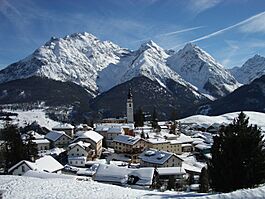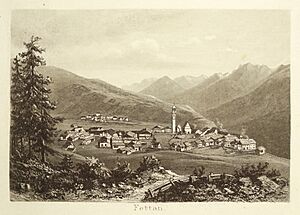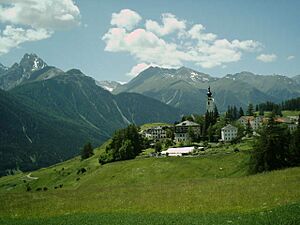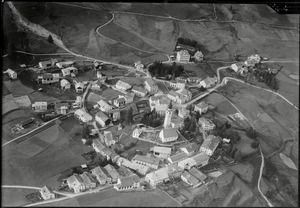Ftan facts for kids
Quick facts for kids
Ftan
|
||
|---|---|---|
 |
||
|
||
| Country | Switzerland | |
| Canton | Graubünden | |
| District | Inn | |
| Area | ||
| • Total | 43.11 km2 (16.64 sq mi) | |
| Elevation | 1,648 m (5,407 ft) | |
| Population
(Dec 2014)
|
||
| • Total | 492 | |
| • Density | 11.413/km2 (29.56/sq mi) | |
| Postal code |
7551
|
|
| Surrounded by | Ardez, Galtür (AT-7), Ramosch, Scuol, Sent, Tarasp | |
Ftan is a village in the Swiss canton of Graubünden. It used to be its own municipality.
On January 1, 2015, Ftan joined with other villages. These were Ardez, Guarda, Tarasp, and Sent. They all became part of the larger municipality of Scuol.
Contents
Ftan's Past: A Look at Its History
Ftan was first mentioned in old writings in 1150. Back then, it was called Vetane. In the 12th century, powerful families from Tarasp owned land here. They also gave gifts to local monasteries.
Ftan became a known church area in 1492. Around 1542, the village became Protestant. This was a big change in its religious life.
The village faced tough times. In 1499 and again in 1622, Austrian soldiers destroyed Ftan. But in 1652, the people of Ftan bought their freedom from Austria. This was a very important moment for them.
Challenges and Changes in Ftan
From the 1500s to the 1800s, Ftan was often hit by natural disasters. Avalanches and village fires caused a lot of damage. The last major fire happened in 1885.
To protect the village, people started building barriers in 1875. They also began planting many trees. This helped to stop future avalanches.
A main road was built in the valley below Ftan between 1860 and 1862. This meant less traffic went through the village itself. The Rhaetian Railway station, opened in 1913, is also far below Ftan.
Ftan's Economy: From Farming to Tourism
For many years, the people of Ftan mostly lived by farming. They grew crops to feed themselves. In the 1950s, things changed. The village started to focus more on raising animals.
In 1970, the first ski lifts opened near Ftan. This brought many visitors in winter. Winter tourism grew very fast. Many holiday homes were built for people coming to ski.
Where Ftan Is: Geography and Landscape
Ftan covers an area of about 43.1 square kilometers (16.6 square miles). A large part of this land, about 40.6%, is used for farming. Forests cover about 15.4% of the area.
Only a small part, 1.2%, has buildings or roads. The rest of the land, about 42.8%, is made up of rivers, glaciers, or mountains. This means much of Ftan is natural and wild.
The village is located in the Inn district. It sits on a flat area high above the Inn river. Ftan has two main parts: Ftan Grond and Ftan Pitschen. Before 1943, the village was known as Fetan.
Who Lives in Ftan: Demographics
In 2014, Ftan had a population of 492 people. About 11.2% of the people living there were from other countries in 2008. Over the last 10 years, the number of people in Ftan has grown by about 9.6%.
Age Groups in Ftan
In 2000, the population was almost evenly split between males and females. About 49.2% were male and 50.8% were female.
Here's how the age groups looked in 2000:
- Children (0-9 years old): 57 children, or 11.0% of the population.
- Young teenagers (10-14 years old): 40 teenagers, or 7.8%.
- Older teenagers (15-19 years old): 84 teenagers, or 16.3%.
- Young adults (20-29 years old): 39 people, or 7.6%.
- Adults (30-39 years old): 65 people, or 12.6%.
- Middle-aged adults (40-49 years old): 69 people, or 13.4%.
- Older adults (50-59 years old): 53 people, or 10.3%.
- Seniors (60-69 years old): 43 people, or 8.3%.
- Older seniors (70-79 years old): 48 people, or 9.3%.
- Very old (80-89 years old): 15 people, or 2.9%.
- Extremely old (90-99 years old): 3 people, or 0.6%.
Education and Jobs in Ftan
Many adults in Ftan have a good education. About 81.8% of people aged 25-64 have finished high school or gone on to higher education. This could be a university or a specialized college.
Ftan has a very low unemployment rate, at 0.81%. This means most people who want to work can find a job.
In 2005, many people worked in different areas:
- Primary sector: 64 people worked in farming or related businesses. There were 24 such businesses.
- Secondary sector: 16 people worked in manufacturing or construction. There were 6 businesses in this area.
- Tertiary sector: 180 people worked in services, like tourism or shops. There were 25 businesses in this sector.
Historical Population Numbers
Here is how Ftan's population has changed over the years:
| year | population |
|---|---|
| 1835 | 538 |
| 1850 | 506 |
| 1900 | 403 |
| 1950 | 504 |
| 1970 | 425 |
| 2000 | 516 |
Languages Spoken in Ftan
Most people in Ftan speak Rhaeto-Romance. In 2000, about 57.8% of the population spoke this language. The second most common language is German, spoken by 37.0% of people. Italian is spoken by a smaller group, about 1.2%.
Here's a table showing the language changes over time:
| Languages | Census 1980 | Census 1990 | Census 2000 | |||
|---|---|---|---|---|---|---|
| Number | Percent | Number | Percent | Number | Percent | |
| German | 139 | 31.95% | 153 | 33.77% | 191 | 37.02% |
| Romansh | 251 | 57.70% | 263 | 58.06% | 298 | 57.75% |
| Italian | 19 | 4.37% | 14 | 3.09% | 6 | 1.16% |
| Population | 435 | 100% | 453 | 100% | 516 | 100% |
Hochalpines Institut Ftan: A Special School
In 1793, a priest from Ftan named Andrea Rosius à Porta started a school. It was for both boys and girls. This school was open until 1869.
Later, in 1916, a new school called Hochalpines Töchterinstitut opened. This school was mainly for girls. In the 1970s, it also became a high school for the region. It offers diplomas that are recognized by the government. Since 1993, it has been known as the Hochalpines Institut Ftan.
See also
 In Spanish: Ftan para niños
In Spanish: Ftan para niños








